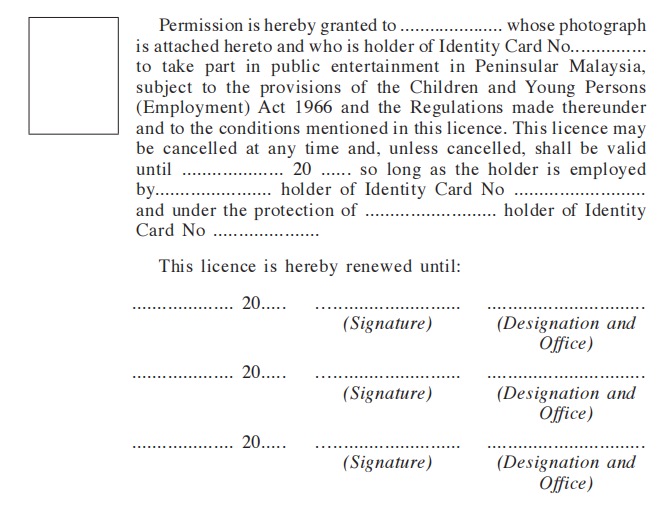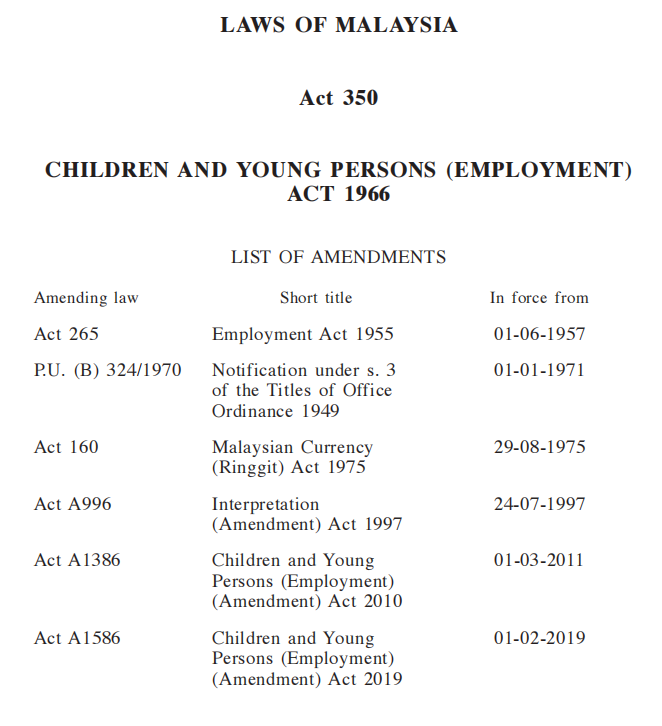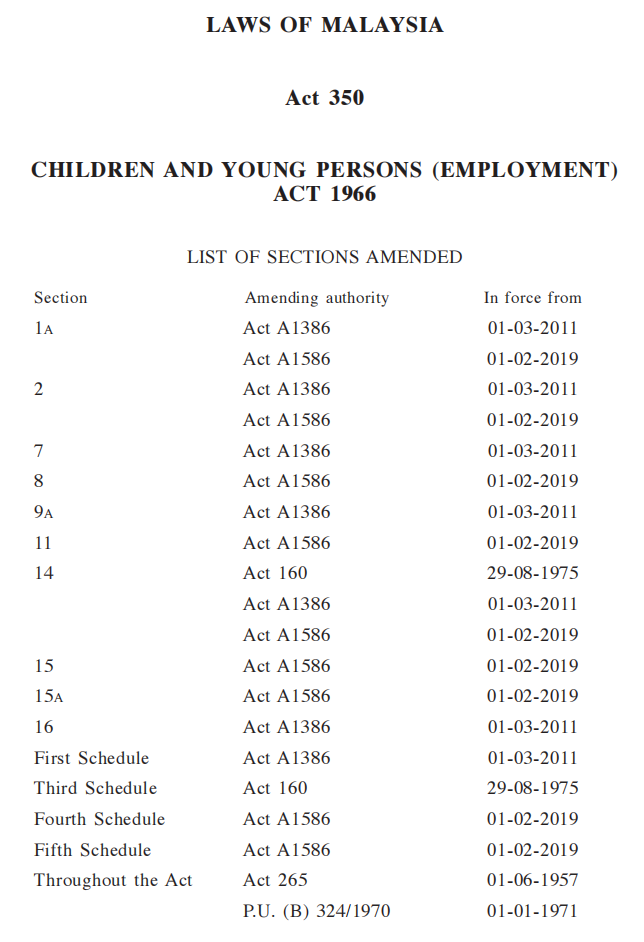|
LAWS OF MALAYSIA REPRINT Act 350 CHILDREN AND YOUNG PERSONS (EMPLOYMENT) ACT 1966 As at 1 October 2019 PUBLISHED BY THE COMMISSIONER OF LAW REVISION, MALAYSIA UNDER THE AUTHORITY OF THE REVISION OF LAWS ACT 1968 ARRANGEMENT OF SECTIONS Section 1. Short title and application 1a. Interpretation EMPLOYMENT 2. Employment in which children and young persons may be engaged 3. The Minister may prohibit any child or young person from engaging or being engaged in any employment 4. Number of days work 5. Hours of work of children 6. Hours of work of young persons PUBLIC ENTERTAINMENT 7. Employment connected with public entertainment INQUIRY INTO WAGES 8. (Deleted) MISCELLANEOUS 9. Administration and enforcement 9a. Offence by body corporate, etc. 10. Jurisdiction 11. Prosecutions and right of audience 12. Certificate of medical officer as to age Section 13. Contractual capacity 14. Penalty 15. Regulations 15a. Power to amend Schedules 16. Application of certain provisions of the Employment Act 1955 and regulations made thereunder 17. (Omitted) 18. Saving First schedule (Deleted) second schedule (Omitted) third schedule Fourth schedule FiFth schedule An Act to regulate the employment of children and young persons. [1 October 1966, P.U. 356/1966] BE IT ENACTED by the Seri Paduka Baginda Yang di-Pertuan Agong with the advice and consent of the Dewan Negara and Dewan Rakyat in Parliament assembled, and by the authority of the same, as follows: Short title and application 1. (1) This Act may be cited as the Children and Young Persons (Employment) Act 1966. (2) This Act shall apply only to the States of *Peninsular Malaysia. Interpretation 1a. (1) In this Act, unless the context otherwise requires — “agricultural undertaking” means any work in which any person is employed under a contract of service for the purposes of agriculture or horticulture, the tending of domestic animals and poultry or the collection of the produce of any plants or trees, but does not include any work performed in a forest; *NOTE—All references to “West Malaysia” shall be construed as reference to “Peninsular Malaysia”–see the Interpretation (Amendment) Act 1997 [Act A996] subsection 5(2). “child” means a person under the age of fifteen years; “contract of service” means any agreement, whether oral or in writing and whether express or implied, whereby a person agrees in accordance with the provisions of this Act to employ a child or young person and that child or young person agrees to serve him and includes an apprenticeship contract; “employ” and “employment” mean employment in any labour for the purposes of gain, whether the gain be to a child, young person or to any other person; “employer” means any person who has entered into a contract of service to employ any child or young person and includes the agent, manager or factor of such first-mentioned person; “entertainment” includes any exhibition or performance; and a person is deemed to take part in an entertainment when such person is employed in or connected with such entertainment whether as a performer, stage-hand or musician; “family” means a parent, sibling or guardian who has custody, of a child or young person; “guardian” in relation to child or young person, includes any person who, in the opinion of the court having cognizance of any case in relation to the child or young person or in which the child or young person is concerned, has for the time being the charge of or control over the child or young person; “light work” means any work performed by a child or young person which is not likely — (a) to be harmful to his health, mental, or physical capacity; or (b) to prejudice his attendance at school that includes any place which teaches any religion, his participation in vocational orientation or training programmes approved by the competent authority or his capacity to benefit from the instruction received; “Minister” means the Minister for the time being charged with responsibility for human resources; “public entertainment” means entertainment to which the public or any section of the public is admitted or in connection with which any charge, whether for admission or not, is made or at which any collection or subscription is received and includes performances for the making of films for public exhibition other than news films but does not include any entertainment given by the pupils of any school registered under the *Education Act 1961 [Act 43 of 1961] at or under the auspices of such school, or any entertainment promoted by a voluntary, social or welfare body which has been approved by the Director General; “vessel” includes any ship or boat or any other description of vessel used in navigation; “young person” means a person who has attained the age of fifteen years and under the age of eighteen years. (2) Other expression have the same meanings as in the Employment Act 1955 [Act 265] and the Weekly Holidays Act 1950 [Act 220]. EMPLOYMENT Employment in which children and young persons may be engaged 2. (1) For the purpose of this section, “hazardous work” means work specified in the Fourth Schedule. (1a) No child or young person shall be, or be required or permitted to be, engaged in any hazardous work, or any employment other than those specified in this section. *NOTE—The Education Act 1961 [Act 43 of 1961] has since been repealed by the Education Act 1996 [Act 550]–see section 155 of Act 550. (1b) Notwithstanding subsection (1a), a young person may be engaged in any hazardous work with personal supervision if he is — (a) under an apprenticeship contract; or (b) undergoing a vocational training. (2) A child maybe engaged in any of the following employments: (a) employment involving light work suitable to his capacity in any undertaking carried on by his family; (b) employment in any public entertainment, in accordance with the terms and conditions of a licence granted in that behalf under this Act; (c) employment requiring him to perform work approved or sponsored by the Federal Government or the Government of any State and carried on in any school, training institution or training vessel; and (d) employment as an apprentice under a written apprenticeship contract approved by the Director General with whom a copy of such contract has been filed. (2a ) The age of admission to light work as specified in paragraph (2)(a) shall not be less than thirteen years. (2b) Notwithstanding subsections (2) and (3), no child or young person shall be, or be required or permitted to be, engaged in any employment specified in the Fifth Schedule. (3) A young person may be engaged in any of the following employments: (a) any employment mentioned in subsection (2); and in relation to paragraph (a) of that subsection any employment suitable to his capacity (whether or not the undertaking is carried on by his family); (b) (Deleted by Act A1586); (c) employment in any office, shop (including hotels, restaurants and stalls), godown, factory, workshop, store, boarding house, theatre, cinema or association; (d) employment in an industrial undertaking suitable to his capacity; and (e) employment on any vessel under the personal charge of his parent or guardian. (4) The Minister may, if he is satisfied that any employment (not mentioned in subsection (2) or subsection (3)) is not dangerous to life, limb, health, safety or morals, by order declare such employment to be an employment in which a child or young person may be, or permitted to be, engaged; and the Minister may in such order impose such conditions as he deems fit and he may at any time revoke or vary the order or may withdraw or alter such conditions. (5) No child or young person shall be, or be required or permitted to be, engaged in any employment contrary to the provisions of the Factories and Machinery Act 1967 [Act 139], the Occupational Safety and Health Act 1994 [Act 514] or the Electricity Supply Act 1990 [Act 447]. (6) (Deleted by Act A1586). The Minister may prohibit any child or young person from engaging or being engaged in any employment 3. Notwithstanding the foregoing provisions, the Minister may, in any particular case, by order prohibit any child or young person from engaging or from being engaged in any of the employments mentioned in section 2 if he is satisfied that having regard to the circumstances such employment would be detrimental to the interests of the child or young person, as the case may be. 4. No child or young person engaged in any employment shall in any period of seven consecutive days be required or permitted to work for more than six days. Hours of work of children 5. (1) No child engaged in any employment shall be required or permitted — (a) to work between the hours of 8 o’clock in the evening and 7 o’clock in the morning; (b) to work for more than three consecutive hours without a period of rest of at least thirty minutes; (c) to work for more than six hours in a day or, if the child is attending school, for a period which together with the time he spends attending school, exceeds seven hours; or (d) to commence work on any day without having had a period of not less than fourteen consecutive hours free from work. (2) Paragraph (1)(a) shall not apply to any child engaged in employment in any public entertainment. Hours of work of young persons 6. (1) No young person engaged in any employment shall be required or permitted — (a) to work between the hours of 8 o’clock in the evening and 6 o’clock in the morning; (b) to work for more than four consecutive hours without a period of rest of at least thirty minutes; (c) to work for more than seven hours in any one day or, if the young person is attending school, for a period which together with the time he spends attending school, exceeds eight hours: Provided that if the young person is an apprentice under paragraph 2(2)(d), the period of work in any one day shall not exceed eight hours; or (d) to commence work on any day without having had a period of not less than twelve consecutive hours free from work. (2) Paragraph (1)(a) shall not apply to any young person engaged in employment in an agricultural undertaking or any employment in a public entertainment or on any vessel under paragraph 2(3)(e). PUBLIC ENTERTAINMENT Employment connected with public entertainment 7. (1) No child or young person shall take part or be required or permitted to take part in any public entertainment unless there has been issued by the Director General of Labour or by such other Director General as may be authorized in writing in that behalf by the Director General of Labour to the person employing such child or young person a licence in that behalf; and the Director General may, in addition to such conditions or restrictions as may be prescribed from time to time under section 15, impose in respect of such licence (whether at the time the licence is issued or thereafter from time to time) such conditions as he deems fit. (2) No licence under subsection (1) shall be granted by the Director General to any person where he is of the opinion that the employment is dangerous to the life, limb, health, safety or morals of the child or young person aforesaid. (3) The Director General may cancel any licence issued under this section on any ground for which he could refuse to issue a licence or on breach of any condition thereof, and such cancellation shall take effect forthwith until and unless set aside on appeal. (4) Any child or young person or the parent or guardian of such child or young person or any other person aggrieved by the decision of the Director General aforesaid may within fourteen days of the making of that decision appeal to the Minister, and the decision of the Minister shall be final. (5) In the event of an appeal, the child or young person or the parent or guardian of such child or young person shall be entitled to be supplied by the Director General the reasons in writing for the cancellation of or refusal to issue a licence or for the imposition of conditions on a licence. 8. (Deleted by Act A1586). MISCELLANEOUS Administration and enforcement 9. The Director General of Labour and such other officers appointed under section 3 of the Employment Act 1955 to carry out the provisions of that Act, shall be charged with the responsibility for the carrying out of the provisions of this Act; and references in this Act to the Director General shall unless the context otherwise requires be construed as references to any one of these officers. Offence by body corporate, etc. 9a. Where an offence under this Act has been committed by a body corporate, partnership, society or trade union — (a) in the case of a body corporate, any person who is a director, manager, or other similar officer of the body corporate at the time of the commission of the offence; (b) in the case of a partnership, every partner in the partnership at the time of the commission of the offence; and (c) in the case of a society or trade union, every office-bearer of the society or trade union at the time of the commission of the offence, shall be deemed to have committed the offence and may be charged jointly or severally in the same proceedings as the body corporate, partnership, society or trade union. Jurisdiction 10. Without prejudice to the jurisdiction of the High Court or the Sessions Court, the Court of a First Class Magistrate shall have jurisdiction to try any offence against this Act and to award the full punishment prescribed. Prosecutions and right of audience 11. (1) Proceedings for offences against this Act or against any order or regulation made thereunder shall not be instituted or conducted except by or on behalf of the Public Prosecutor. (2) The Director General shall have the right to appear and be heard in any proceedings under this Act, and such right shall include the right to appear and represent a child or young person in any such proceedings. Certificate of medical officer as to age 12. Where, in any proceeding under this Act, a person is alleged to be a child or young person, the Court may accept a certificate of a Government Medical Officer to the effect that, in his opinion, such person is or is not a child or young person. Contractual capacity 13. Notwithstanding anything to the contrary contained in the Contracts Act 1950 [Act 136] or the provisions of any other written law, any child or young person shall be competent to enter into a contract of service under this Act otherwise than as an employer, and may sue as plaintiff without his next friend or defend any action without a guardian ad litem: Provided that no damages and no indemnity under section 13 of the Employment Act 1955, shall be recoverable from a child or young person for a breach of any contract of service. Penalty 14. (1) Any person contravening any of the provisions of this Act or of any regulations or order made thereunder or who being the parent or guardian of a child or young person knowingly acquiesces in any such contravention in respect of such child or young person shall be guilty of an offence and shall be liable on conviction to imprisonment for a term not exceeding two years or to a fine not exceeding fifty thousand ringgit or to both and, in the case of a second or subsequent offence, shall be liable on conviction to imprisonment for a term not exceeding five years or to a fine not exceeding one hundred thousand ringgit or to both. (2) On the conviction of any person for an offence under subsection (1) the Director General shall, if the person convicted is the holder of a licence under the *Theatres and Places of Public Amusement Enactment 1936 of the Federated Malay States [F.M.S. 47 of 1936] or under any other corresponding written law in force, inform the licensing authority concerned of the particulars of such conviction and the licensing authority may take such action as it considers appropriate. Regulations 15. (1) The Minister may make regulations for carrying out any of the purposes of this Act. (2) In particular and without prejudice to the generality of the foregoing, the Minister may make regulations to prescribe — (a) the form of licence to be issued under section 7 and the conditions and restrictions to be attached to such licence; and (b) the times which children and young persons employed shall be entitled to take off from work for meals or as rest periods. (c) (Deleted by Act A1586). *NOTE—The Theatres and Places of Public Amusement Enactment 1936 of the Federated Malay States [F.M.S. 47 of 1936] has since been repealed by the Theatres and Places of Public Amusement (Federal Territory) Act 1977 [Act 182]. The Theatres and Places of Public Amusement (Federal Territory) Act 1977 has since been repealed by the Entertainment (Federal Territory of Kuala Lumpur) Act 1992 [Act 493] which came into force on 1 October 1993. Children and Young Persons (Employment) 15 (3) The regulations contained in the Third Schedule shall have effect unless and until replaced or amended by regulations made under this section, and shall be deemed to be regulations made under this section. Power to amend Schedules 15a. The Minister may, by order published in the Gazette, amend the Schedules to this Act. Application of certain provisions of the Employment Act 1955 and regulations made thereunder 16. The provisions of the Employment Act 1955 and of any regulations made thereunder, shall apply to the employment of any child or young person under this Act, as if those provisions were enacted in and form part of this Act; and references in those provisions to “contract of service” and “employer” shall be construed accordingly. 17. (Omitted). Saving 18. Nothing in this Act shall be construed as relieving any person who has entered into a contract of service, either as an employer or employee, of any rights, duties or liabilities conferred or imposed upon him by the provisions of any other written law for the time being in force in the States of *Peninsular Malaysia or to limit any power which may be exercised by any public officer pursuant to any such provisions. *NOTE—All references to “West Malaysia” shall be construed as reference to “Peninsular Malaysia”–see the Interpretation (Amendment) Act 1997 [Act A996]. First schedule [Section 16] (Deleted by Act A1386) second schedule [Section 17] (Omitted) third schedule CHILDREN AND YOUNG PERSONS (EMPLOYMENT) REGULATIONS 1966 Short title 1. These Regulations may be cited as the Children and Young Persons (Employment) Regulations 1966. Interpretation 2. Unless there is something repugnant in the subject or context, words and expressions used in these Regulations have the meaning respectively assigned to them by the Children and Young Persons (Employment) Act 1966 (hereinafter in these Regulations referred to as the “Act”). CONDITIONS OF LABOUR Production of children for inspection 3. Any child employed in any form of labour shall be produced, or caused to be produced, by his employer for inspection at any time during working hours or at any other reasonable time upon the demand of — (a) a Director General; (b) a Magistrate; or (c) any person authorized in that behalf by the Director General of Health, the Director General of Labour or the Director General of Social Welfare. PUBLIC ENTERTAINMENTS Medical examinations 4. Every child and young person taking part in any public entertainment shall be produced by the employer of such child or young person or by his agent for examination and shall be examined by a Government Medical Officer in the first instance and thereafter not less than once in every three months, and such Medical Officer shall report the result of his examination to the Director General. Form of licence 5. A licence to take part in a public entertainment issued under section 7 of the Act shall be in the form as set out in the Schedule to these Regulations, with such modifications as the circumstances may require. Such licence shall provide — (a) the maximum number of performances to be given in any one day or week; (b) the maximum number of performances to be given consecutively; (c) the hours of the day between which a child or young person shall not take part in a public performance; (d) that no performance shall exceed four hours in duration; (e) that a child or young person shall not take part in any performance which is dangerous to life, limb, health or morals; (f) that a child or young person shall report in person or in writing to an Assistant State Director of Labour or a State Director of Labour when leaving the service of the present employer; (g) that a child or young person shall report to an Assistant State Director of Labour or a State Director of Labour in writing or in person when leaving the District or State and give the destination; (h) that a child or young person shall report arrival in any District to the nearest Labour Office in writing or in person; and (i) any other conditions or remarks. Penalty 6. Any person who shall employ any child or young person in breach of any of the provisions of these Regulations or who shall fail to produce a child or young person when required under the provisions of regulation 3 or shall otherwise contravene the provisions of these Regulations, shall be guilty of an offence and shall, where no other penalty is provided by the Act, be liable to a fine not exceeding two hundred and fifty ringgit or to imprisonment for a term which may extend to six months or to both such fine and imprisonment. Revocation 7. The Children and Young Persons Rules 1947 [G.N. 8529 of 1947] (except rule 17 in so far as it relates to Forms I, II and IV to X of the Schedule thereto) are hereby revoked.
CHILDREN AND YOUNG PERSONS (EMPLOYMENT) ACT 1966 [Section 7—Regulation 5] LICENCE TO TAKE PART IN A PUBLIC ENTERTAINMENT CONDITIONS 1. Not more than ..................... performances to be given in any one week. 2. Not more than ..................... performances to be given in any one day with a minimum interval of ....... hours between successive performances. 3. No performance to exceed four hours in duration. 4. Not to take part in any performance which is dangerous to life, limb, health or morals. 5. To report in person or in writing to an Assistant State Director of Labour or a State Director of Labour when leaving the service of the present employer. 6. To report to an Assistant State Director of Labour or a State Director of Labour in writing or in person when leaving the District or State and to give the destination. 7. To report arrival in any District to the nearest Labour Office in writing or in person. 8. To appear before a Government Medical Officer for examination not less than once in every three months. 9. Other conditions or remarks : ...............................................................................................
Fourth schedule [Subsection 2(1)] List of hazardous work A. WORK RELATED TO MACHINES, INSTALLATIONS AND OTHER EQUIPMENT 1. Machinery (a) Any machine tools or production machine which can pose high risk such as drilling machines, grinding machines, cutting machines, lathes machines, scraping machines, power press machine, knitting machines, weaving machines, packaging machines and bottling machines; (b) Steam boiler or internal combustion engine such as diesel engines, turbines and engines for generating electricity; (c) Hoisting and loading machine such as lift, hoist, crane, escalators, conveyor belts, gondolas and forklift; or (d) High pressure vessels. 2. Heavy-duty machine such as tractors, rock breakers, graders, asphalt mixers, piling machine and agriculture machinery. 3. Installations such as pressure pipe, electricity, firefighting system and electricity transmission lines. B. WORK CONDUCTED IN HAZARDOUS ENVIRONMENT 1. Work that is exposed to physical hazards (a) Underground work, underwater or in a confined space such as a well or a tunnel; (b) Working at height which can lead to serious bodily injury; (c) Working environment which involves electricity at high voltage power line; (d) Working in a caisson with limited ventilation; (e) Work that uses electric welding machines or gas welding machines; (f) Work in an environment with extreme temperature and moisture or high-speed wind; (g) Work in an environment with noise or vibration where intensity exceeds the permissible exposure limits; (h) Work to handle, store, use and transport radioactive substances; (i) Work that produces ionizing radiation or work in an environment with ionizing radiation; (j) Work in a dusty environment that is detrimental to health; (k) Work which may lead to electrocution, fire or explosion; or (l) Manual handling works which may pose high risk such as lifting, lowering, pushing, pulling, carrying or moving a load. 2. Work that is exposed to chemical hazards (a) Work in relation to production, processing, handling, storage, transport, removal, disposal or treatment of hazardous chemical as defined in the Occupational Safety and Health (Classification, Labelling and Safety Data Sheet of Hazardous Chemicals) Regulations 2013 [P.U. (A) 310/2013]; or (b) Work in relation to production, processing, handling, storage, transport, removal, disposal or treatment of pesticides and schedule waste as defined in the Pesticides Act 1974 [Act 149] and the Environmental Quality (Scheduled Wastes) Regulations 2005 [P.U. (A) 294/2005]. 3. Work that is exposed to biological hazards Work in an environment that relates to germs, bacteria, viruses, fungi, parasites and other biological agents such as works in clinical laboratories, slaughter house, meat processing place and silo or storage for storing crops. C. WORK CONTAIN CERTAIN HAZARDOUS NATURE AND CONDITION 1. Construction work including construction of building, bridges, roads, or irrigation project. 2. Work in timber industry such as cutting, transporting and unloading trees. 3. Work offshore such as working in a petroleum platform. 4. Work above or near water where the risk of drowning exist such as lifeguard, fishing activities and work in water treatment plant. FiFth schedule [Subsection 2(2b)] Employment in which children or young persons shall not be required, permitted to be or engaged in — 1. All kind of employment that make use of, procure, or offer children or young persons for prostitution. 2. All kind of employment as social escorts, hostesses and any other related activities. 3. All kind of employment that require children or young persons to involve in the production or trade of alcoholic beverages. 4. All kind of employment related to gambling and lotteries activities. 5. All kind of employment that require children or young persons to work in any activities related to massage services or reflexology services. 6. All kind of employment that make use of, procure, or offer children or young persons for any kind of job related to pornography. 7. All kind of employment that make use of, procure, or involve children or young persons for the production and trade of drugs, narcotics, psychotropic substances and other addictive substances which are prohibited under any written law in operation.
| 
 京公网安备 11010802035448号
( 京ICP备19053597号-1,电话18600416813,邮箱1479971814@qq.com ) 了解Tax100创始人胡万军
优化与建议
隐私政策
京公网安备 11010802035448号
( 京ICP备19053597号-1,电话18600416813,邮箱1479971814@qq.com ) 了解Tax100创始人胡万军
优化与建议
隐私政策
 京公网安备 11010802035448号
( 京ICP备19053597号-1,电话18600416813,邮箱1479971814@qq.com ) 了解Tax100创始人胡万军
优化与建议
隐私政策
京公网安备 11010802035448号
( 京ICP备19053597号-1,电话18600416813,邮箱1479971814@qq.com ) 了解Tax100创始人胡万军
优化与建议
隐私政策

 【全网最全】31个省市!残保金政策汇编及申
【全网最全】31个省市!残保金政策汇编及申
 全网最全|2022年失业保险稳岗补贴政策汇总
全网最全|2022年失业保险稳岗补贴政策汇总
 2021年个税汇算容易出现哪些错误?税务总局
2021年个税汇算容易出现哪些错误?税务总局
 【全网最全】历史上最高规模退税减税!2022
【全网最全】历史上最高规模退税减税!2022






